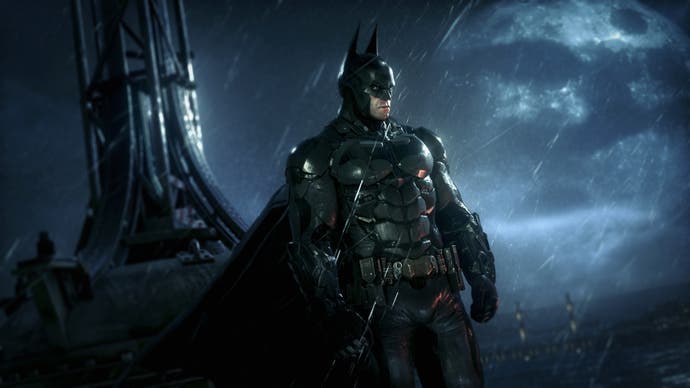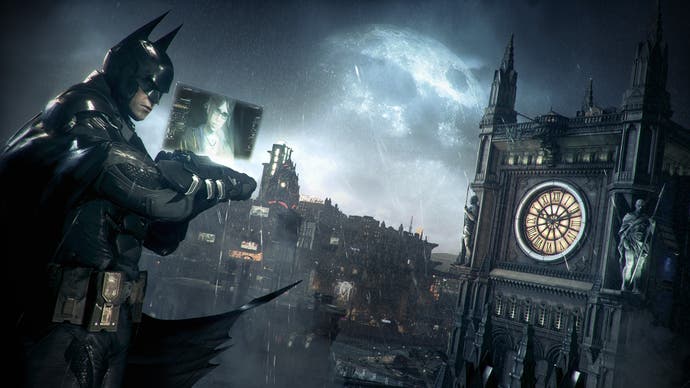How the Batmobile opens up Arkham Knight's next-gen Gotham
"Working on next-gen was a no-brainer - we couldn't have straddled both generations."
When it comes to big sequels in big franchises, big numbers speak louder than all else. Louder, even, than Rocksteady's ever-enthusiastic producer Dax Ginn, who's just finished screaming his way through an energetic presentation of Batman: Arkham Knight, the concluding chapter of a trilogy kick-started with 2009's exceptional Arkham Asylum.
Above all the noise about new features like the introduction of the Batmobile and a Gotham only possible on the new generation of consoles, there's one set of numbers that stands out: Arkham Knight will be 20 times the size of Arkham Asylum, and five times bigger than the open world of Arkham City. It's an impressive statistic, but one that highlights an underlying problem many people had with Arkham City, a sequel lacking some of the focus of its predecessor. Wouldn't it be more impressive to boast of a world five times smaller? Is bigger necessarily always better?
"When you've got the Batmobile, yeah," Ginn replies with a note of confidence. "We couldn't have gone five times smaller and had an awesome Batmobile experience. We need to be clear about what this game is going to bring that's different and new and exciting. The answer? The Batmobile. So what's going to need to change in order to make that incredible? That justifies the size."

If you want to know where Arkham Knight really builds upon its predecessors, then, it's in the trundling, violent and achingly cool Batmobile. It's the star of the short hands-off demo, and it more than earns top-billing, tearing through the city's destructible scenery with the kiddish abandon of a Matchbox car, with squat physics to suit. It looks like the ultimate toy with which to take to the ultimate sandbox, Rocksteady's new, improved and more expansive Gotham - and when game director Sefton Hill said the studio's setting out to make nothing less than the best car in games, it turns out his statement wasn't so ludicrous after all.
Like any beloved kid's toy, the Batmobile's always close to hand. It can be summoned at any point by the player, bounding into view through Gotham's black streets like an over-eager puppy, and the mounts and dismounts possible from the vehicle are a thing of beauty of themselves. Batman can glide in from up above before sliding into the cockpit, or even more entertainingly can hurl himself out from the vehicle, using the velocity to set up ludicrous parabolas over the cityscape. From up in Gotham's gloomy heavens the scope of Rocksteady's new city really comes into view, stretching out in detail to impressively distant horizons.
Back at street level, Gotham is a more characterful place than the sometimes drab, indistinguishable districts of Arkham City. Through all the chaos churned up by the Batmobile - and there really is an awful lot of chaos, with a heavy storm of litter and debris circling the vehicle when it hits speed - a sense of identity begins to emerge. There are the dreary slums, of course, but there are now splashes of colour too: Chinatown streams by in a flash of lurid neon, the wet streets glistening with pools of reflected yellow and red light.
"The fantasy of driving at high-speed, being destructive, being powerful and maxing out the game space, because you need a big gameworld to drive that sort of speed. They're all next-gen things."

Gotham feels like a more real, more distinct place, but what's best about Rocksteady's new creation is how it all hangs together. The flow that's defined the Arkham series' combat now bleeds out elsewhere - going from athletic traversal to the Batmobile is a seamless transition, as is heading into a cut-scene, with a roof-top encounter with Commissioner Gordon blending neatly with the gameplay. That very flow of combat has been augmented, too - Batman can now deploy gadgets while gliding, firing off a couple of handy batarangs before embarking into a fight, or spring up on a group of enemies and take them down in one swift move dubbed the fear takedown.
Fear plays a wider part in Arkham Knight's story now, too. The main antagonist is the eponymous Knight, a character created from scratch by Rocksteady in collaboration with DC, though further details are thin on the ground. In their absence, it's the return of Scarecrow that's the more tantalising proposition. There's no hope of a last-minute reprise for the Joker, who was seen off at the end of Arkham City ("The Joker is dead," insists Ginn, "dead and buried"), allowing for one of Gotham's more sinister, more playful villains to take centre stage. Rocksteady has already displayed an affinity with the character in Arkham Asylum's twisted set-pieces, and it'll be fascinating to see how it blends such misdirection into the broader, more open world of Arkham Knight.
It all neatly loops Rocksteady's Arkham series back on itself, closing a trilogy Ginn insists was always the plan from the off. "I know it's easy to say that now, but the narrative structure of Joker and Scarecrow kind of being of similar levels of power in Arkham Asylum, then focussing exclusively on Joker in Arkham City, killing him at the end of it and then bringing Scarecrow back for Arkham Knight. That was always the high-level plan for what these villains are doing.

"Really, the Batmobile was the missing piece," Ginn continues, before explaining why Arkham Knight is only possible on the new generation of hardware. "We wanted to go big on it, and once we realised that's what we want to do, all of our technical decisions fell into place. The fantasy of driving at high-speed, being destructive, being powerful and maxing out the game space, because you need a big game world to drive that sort of speed. They're all next-gen things. So having the opportunity to work exclusively on next-gen and really commit to that - it's a no-brainer in that respect. It's all or nothing. We couldn't have straddled both generations and hoped for an awesome experience."
There will be more Batman games, of course, most likely courtesy of Arkham Origins' developer Warner Montreal (tellingly, Rocksteady won't be drawn on its feelings on last year's less than stellar outing, merely trotting out the standard line that it worked well enough as a prequel). Whether Rocksteady returns to Batman or looks to the wider world of DC, it's a developer at least brave enough to walk away from a series still at its prime.
"It feels like we achieved what we set out to achieve," says Ginn. "I guess it depends on what happens next, that will tell us whether we're complete idiots or we're actually doing the right thing by gamers. I think, as a gamer, I love a sense of completion. Closing the book on something feels very satisfying. From a developer's perspective, it gives us the opportunity to say what's next: do we look at Batman from a completely different perspective, or do we do something else?"
Arkham Knight looks ready to close the trilogy with no small amount of bombast, then. Beyond that, the open book presented to Rocksteady is full of exciting possibilities - and you can be sure that, wherever the studio ends up next, Ginn will be there to make a noise about it.





.png?width=291&height=164&fit=crop&quality=80&format=jpg&auto=webp)



